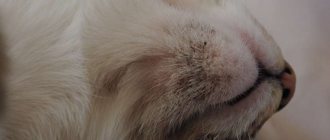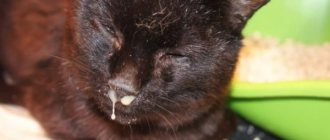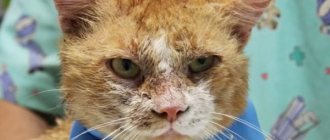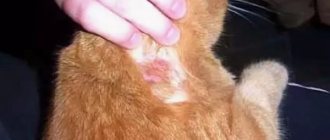As much as you love your feline companions, it's easy to worry about any new thing on their faces, from crusty eyes to nasal discharge. Blackheads often appear on your cat's nose, and this can be a cause for concern. So, have you ever wondered what that black thing is on a cat's nose?
The black stuff on your cat's nose is caused by boogers, mucous nasal discharge from dust, or scabs. Small spots of dried blood are signs of a bacterial infection. Feline herpes or lentigo can also cause discoloration of the nose.
It's good that you're paying attention too: cats' tears and other things on their faces can be an indicator of their health. Sometimes this discharge tells you that your cat is healthy, and sometimes this discharge can be the first sign of a problem and a sign that it is time to see a veterinarian.
Causes
But is everything as dangerous as the brain, “inflamed” from thinking, portrays? There is no need to rush to bother the doctor and take extra money to the clinic. First, you should figure out what caused the crusts to appear; to do this, you need to carefully examine your pet’s body. Wounds and scabs in tailed pets can occur as a result of various events. The most common causes of crust formation on a cat's nose are:
A sore on the tip of a cat’s muzzle can take quite a long time to heal. If the owner is completely confident in the nature of the wound and knows that nothing threatens the pet’s health, he can treat the sore nose himself.
Injury
If the cat slightly hit his nose on some object, and as a result of this a crust formed on the wound, there is no need to worry too much. The sore may occur due to injury during a fight between relatives. Thin, delicate skin is easily injured even during normal home games. The crust may represent clotted blood if the animal has had a nosebleed. Then you should monitor the condition of the fluffy. If his breathing is normal, there are no hematomas in other parts of the body, and the scabs do not become wet, then the danger has passed.
For speedy healing, it is advisable to treat the scabs with an antiseptic, but only if they begin to fester. If left untreated, the wound may become infected. Then the cat's health may suffer serious consequences.
It is worth paying special attention to the fact that dry black crusts on a cat’s nose do not need to be treated. “Cauterization” requires only weeping erosions that prevent the animal from breathing normally.
Dermatitis
Skin diseases are no less common cause of crust formation than injuries. Dermatitis is formed due to the introduction of fungi or bacteria into the epidermis of an animal. By the way, some of them can be transmitted to humans.
To identify the real pathogen, you should visit the clinic and submit a scraping for laboratory testing. In addition, the veterinarian will send the patient to the treatment room to take a number of other tests to establish the most accurate clinical picture.
A swab will be taken from the cat's nasal passage, which will determine the state of the microflora. The doctor may suggest illuminating the pet with a special lamp - the manipulation allows you to instantly determine the type of fungus. The regimen and duration of treatment depends on the established diagnosis. Fungal spores are destroyed with the help of appropriate medications - ointments, gels, creams.
Antibacterial drugs, for example, Levomekol, will help fight bacterial infection. True, the lesion, as well as the healthy tissue adjacent to it, is first treated with antiseptics. Miramistin and Chlorhexidine are suitable for cleaning. The preparatory procedure is required. After all, secondary infection can significantly worsen the condition of a sick patient.
Allergic reactions
Allergens can appear in a cat’s body in response to external stimuli:
- food products;
- household chemicals;
- flowering plants;
- veterinary drugs;
- toys, interior items made of low-quality materials;
- synthetic bedding;
- harmful emissions, tobacco smoke;
- gas pollution, dust.
The crusts on your cat’s nose will disappear on their own as soon as histamine returns to normal. To reduce the level of the “raging” hormone, you should give the animal a medicine (Suprastin, Tavegil or Diazolin). Additionally, you need to protect your pet from contact with the allergen.
Photos of cats with crusts on their noses
Infectious diseases
A contagious disease of the upper respiratory tract is calcivirosis. This formidable pathology affects only representatives of the cat family; the virus can lead to the most disastrous consequences - the death of the animal. Pathogenic microorganisms spread throughout the external and internal organs of the pet, filling the eyes, nose, mouth, throat, and lungs. Black crusts on a cat's nose may indicate the penetration of a dangerous infection into the body. In addition to the above sign, the following symptoms can be traced:
- visually visible sores on the tongue, gums;
- nasal discharge (snot);
- ulcers on the mucous membranes with liquid contents;
- profuse salivation and lacrimation;
- apathy towards the environment, lethargy;
- fever;
- lack of appetite;
- swollen lymph nodes;
- pain in the joints, and, as a result, limping.
Possible complications of the disease
Prolonged ignoring of pathology leads to serious complications:
- anosmia - partial or complete loss of smell;
- decreased local immunity;
- inflammation of the trachea, larynx, ears, eyeballs;
- deterioration of memory and intelligence;
- hearing problems;
- nasal deformity;
- pneumonia;
- meningitis;
- gastrointestinal dysfunction: nausea, vomiting, dyspepsia, gastritis;
- depressive states, apathy, neurasthenia.
The most difficult consequence of pathology is the spread of the atrophic process to other organs.
Unfortunately, people often turn to an otolaryngologist with an already advanced form of atrophic dry rhinitis. The doctor prescribes treatment that can make the patient feel better and stop the development of the pathology, but it is no longer possible to return the nasal cavity to a completely healthy state.
If you find at least one symptom of a disorder of the mucous membrane, then you need to contact a qualified specialist. This will allow you to diagnose the disease in time and take the necessary measures to treat it.
Why do crusts appear on my cat's nose?
The cause of the appearance of crusts on the mucous membranes of an animal can be some diseases, physical damage and simple pollution. Cats are very clean and always take care of their bodies. Dirt (crackers, food debris) can stick to the spout and dry out. But usually such phenomena do not last long. Wipe your pet's nose with a damp soft cloth - if the crust is gone and there are no lesions underneath, there is no need to worry.
Infectious diseases
There are infectious diseases that affect the mucous membranes of animals.
Fungal infections (dermatomycosis)
The most common types of fungi that parasitize the nose of cats and dogs are actinomycosis, cryptococcosis, and candidiasis. The cause may be contact infection (from soil, food, sick animals), decreased immunity. The fungus can affect not only the nose, but also other sensitive places: ears, paws (especially between the pads), stomach, eyelids, genitals. The crusts on the nose of a cat of fungal etiology are usually light-colored and flaky. Sometimes - mixed with a small amount of blood and pus. Associated symptoms:
- Sneezing, coughing.
- Rash on the abdomen;
- Itching (cat scratches nose).
- Change in body temperature.
- General malaise: poor appetite, low activity.
Some mycoses occur with few symptoms or develop for a very long time.
Calicivirus
This is a viral disease that affects the mucous membranes, mainly the mouth, nose, and eyelids. Transmitted by contact. Signs of calicivirus:
- Formation of ulcers and erosions on the mucous membranes (when they dry out, crusts remain).
- Conjunctivitis.
- Redness, inflammation of the mucous membranes.
- Shortness of breath (when the mouth is affected).
- Refusal to eat, lethargy, weight loss.
- Temperature increase.
Over a long period of time, the virus causes inflammation in the joints. The animal begins to limp and moves little.
Bordetellosis
A bacterial disease transmitted by contact. Bacteria can be found in water, food, rotting materials, and soil. Most often, cats become infected with bordetellosis from each other. Symptoms:
- Brown crusts on the cat's nose, cracks, sores.
- Purulent discharge from affected tissues.
- Increased body temperature.
- Swelling of the lymph nodes.
- Dyspnea.
- Cough, sneezing.
- Loss of appetite, lethargy.
Photo of crusts on a cat's nose
What else can cause crusts on a cat's nose?
Sores on the nose do not always appear in cats due to infection. There may be other reasons.
Allergy
Artificially bred cat breeds are the most susceptible to allergies. An atypical reaction of an animal’s immune system most often occurs to:
- Food (preservatives, dyes, some additives in food).
- Plants, especially during the flowering period.
- Household chemicals used in the home.
- Synthetic pillows, bedding, toys.
- Tray filler.
- Dust.
- Harmful fumes (especially if there is smoking in the house).
- Some medications.
Injuries
A cat has a dry crust on its nose as a result of an injury received in a street fight. Small, not yet intelligent kittens often scratch themselves while playing. The cat may also hit its nose on a hard object or unsuccessfully jump from a height. With a severe head injury (concussion), the following symptoms are possible:
- Impaired coordination of movements.
- Profuse bleeding from the nose.
- Vomit.
- Visual impairment.
- Loss of consciousness.
- Cramps.
Disease Prevention
Prevention of cat diseases includes:
- Rational, balanced nutrition. Lack of vitamins, microelements and nutrients necessary for the animal weakens the body.
- If it is not planned for cats to continue breeding, but to be kept only as a pet, sterilization (castration) is recommended. Sexual arousal negatively affects the health of animals, leading to congestion in the genitourinary system, fights and injuries.
- White individuals should not be allowed outside all day in the summer.
- Animals that participate in exhibitions or are kept free-range are recommended to be vaccinated. You must first make sure that your pet is healthy and not a virus carrier.
A healthy lifestyle includes minimizing stress. Affectionate, trusting communication with an animal not only maintains an emotional connection, but also strengthens the immune system.
Brown crusts on a kitten's nose. How to clean crusts on a kitten's nose?
The condition of a kitten's nose often indicates the development of very serious diseases, so the appearance of strange brown crusts should not be ignored. Crusts on a kitten's nose sometimes appear due to serious infectious diseases that need to be treated immediately.
Reasons for the problem
The appearance of a crust on a kitten’s nose is an alarming sign of the development of very serious problems. Sometimes such a symptom occurs due to basic damage to the nose. Sensitive tissues may have been damaged during a fight or during exploration of the outside world. Sometimes kittens damage their nose by scratching it on the edge of a table or on sharp objects in the house.
Often, a brown crust appears due to bleeding, which the owner may not have noticed. The remaining blood on the nose hardens, turning into a crust. The bleeding itself may indicate the development of very serious diseases related to the functioning of the brain.
However, the most common reason for the appearance of such crusts is infectious diseases. During viral rhinotracheitis, calicivirosis and reaviral infection, liquid is released from the animal’s nose, which hardens in the form of a brown crust. Your kitten's nose may run all the time for several days. The kitten's activity gradually decreases and his appetite completely disappears. Diseases can also lead to death, because the baby’s body is extremely sensitive to a variety of bacteria.
Another common sign of the development of an infectious disease is the animal’s constant sneezing. If a kitten often rubs its nose or snores in its sleep, then most likely it is suffering from a serious infectious disease, which can only be treated under the supervision of a specialist.
Fungal and skin diseases can cause brown crusts to appear on the nose. Typically, fungal diseases are accompanied by cracks on the paw pads, as well as sudden hair loss, so it is quite difficult not to notice the problem.
How to cure otodectosis in kittens
Accidentally, I clicked send message before and didn’t have time to edit it
Of course, I’m not a doctor, but Stronghold drops help a lot against ticks. We were cured easily and quickly with them. I repeat, I am not a doctor, but it seems to me that the dingo is right that you need to do a scraping from the face and a swab from the ear. Otherwise you can be treated like this endlessly. There may be other bacteria in the ears. I will describe my case, which is somewhat similar to yours.
My first trip/experience to the veterinarian with a kitten was unsuccessful. The kitten scratched its ears and shook its head. The doctor examined him, said that he had swelling, and prescribed two ointments. And he gave several, as it turned out, not the best recommendations. The ears didn't go away. Let's go to another veterinarian. They took a scraping from the ear for a tick. No ticks were found, but there was swelling. We handed over the tank. ear swab. While we were waiting for the result, drops were dripping. A large number of Enterobacteriaceae and Staphylococcus epidermidis were found. Both were highly sensitive only to the expensive Meropenem. While the injections were being given, they told me to smear my face and ears with Oflomelid. Since he was combing them all, sores appeared, his muzzle became pale, and he looked bald. As a result, the ears (otitis media) were cured internally, but the problem remained externally. The doctor was racking her brains and didn’t know what he had. I referred her to a friend who is a dermatologist. At that time, 2 months had passed since the visit to the first doctor, and the kitten was still suffering. We've already gone to the third veterinarian. The young doctor took a scraping from the outside of the ears. I found a tick and said it had Sarcaptosis. She showed the tick under a microscope. As it turned out, Sarcaptosis occurs in dogs, and notoedrosis occurs in cats. She prescribed washing the wounds externally with Chlorhexidine solution. Wash the kitten with Doctor shampoo. Apply Stronghold to the withers once every two weeks. Course 4 times. (I actually later found information that it was enough to treat it 2-3 times, and the fourth time I didn’t start dripping.) I prescribed vitamins for wool, wear a collar. (The collar I bought turned out to be too big and was not worn.) And at the end, drink Heptral. At the forum they said that Stronghold does not damage the liver, so you don’t have to drink Heptral, and we didn’t. Finally, after much suffering, the kitten was cured, however, at that time, I had 2 of them and both were treated. As a result, we spent a lot of time (3 months), money and, most importantly, the kittens suffered all this time. First branch. did not help. The second is partial, only the otitis media was cured, but the usual mite was not found. Third branch. discovered and cured a tick, although he named a different species.
Ways to deal with brown crusts that appear
The first thing to do is to identify the cause of the problem, and only then begin full treatment. If a crust appears on the nose due to bleeding, allergies or mechanical damage, it is necessary to wipe the nose with an alcohol solution. If after this the crust appears again, then the reason is more serious.
If a calicivirus infection develops, you will have to use a whole series of medications prescribed by a specialist. The veterinarian will identify the cause of the disease and then prescribe medications. Self-treatment of a kitten is not acceptable, because the baby’s immunity is greatly weakened, and bad medications can only worsen the pet’s general condition.
If fungal skin lesions occur, special ointments and tablets are prescribed. They must be taken until the signs of the disease disappear completely. In this case, it is necessary to take into account the individual intolerance of the components by a small pet.
Chronic rhinitis also often causes brown crusts to appear. You can fight the disease with the help of special drops, which can be found in large quantities in veterinary pharmacies. Cats are difficult to respond to such treatment, so the animal’s head will have to be pinched in order to pour the drops intended for this into the nose twice a day.
If your kitten develops skin or fungal infections, remember that they can be dangerous to humans. That is why a sick animal must be isolated from communication with people, especially children, at least for the duration of treatment.
A caring owner will always be able to notice strange brown crusts in time and eliminate them before the problem develops further. Such crusts can be associated with the development of very serious diseases, so the symptom should not be ignored.
What is atrophic rhinitis?
Atrophic rhinitis is a long-term inflammatory disease of the nasal mucosa, accompanied by its thinning. Main signs of the disease:
- increased dryness of the nasopharynx,
- viscous discharge of yellow or green color,
- the appearance of specific crusts,
- short-term bleeding.
Over time, most of the structure of the nose is affected: nerve endings, blood vessels, bone tissue. The disease affects adults, mainly women, and children, most often teenagers. However, sometimes atrophic rhinitis is detected in a child in early childhood (from 1 year).
An alternative name for chronic atrophic rhinitis is “dry” runny nose. This is explained by scanty secretions with severe breathing problems.
The disease is divided into two types:
- Primary.
It forms independently; the causes have not been identified to date. - Secondary.
Appears as a consequence of concomitant pathologies or surgical interventions.
Timely detection and subsequent treatment of atrophic rhinitis is extremely important because the disease quickly becomes chronic. If the mucous membranes do not perform protective and thermoregulatory functions, the functioning of most respiratory organs will be disrupted.
Nose injuries
The crusts on your cat's nose may be brownish or black. This symptom is characteristic of a fungal infection, an inflammatory process in the nasopharynx, or an allergic reaction. The most harmless cause of crust formation is considered to be household injuries.
The fact is that a healthy cat's nose is slightly moist. This prevents the normal restoration of damaged skin, so wounds can take a long time to heal. If the owner is absolutely sure of the nature of the crusts, it is necessary to help the pet’s body recover as quickly as possible. To do this, it is recommended to treat your nose with an antiseptic several times a day. Preventing re-infection of the wound significantly accelerates regeneration and the crusts begin to disappear a few days after the start of treatment.
A dark crust on the nose, which is accompanied by discomfort and is a consequence of skin damage, should not be a cause for concern. In this case, no treatment is required; the crust will fall off on its own when the tissues are completely restored.
Treatment with an antiseptic is only necessary if weeping erosions or crusts appear at the site of the wound, blocking the respiratory tract.
Should you clean your cat's nose?
The short answer is yes , you should occasionally clean your cat's nose if she needs it. For example, if you have a cat with allergies, cleaning her nose will help her breathe easier and make her more comfortable.
Some kittens need their nose cleaned from time to time and outgrow it as adults.
Of course, if you need to clean your cat's nose regularly, it's a good idea to visit your veterinarian and find out why.
Cats are very sensitive in the facial area. This means that to clean their nose, they need to be calm and you need to be gentle. If crusts appear on your nose, be especially careful not to scratch or injure them.
Infectious diseases
If a cat has black crusts on his nose that do not heal for a long time, the cause should be sought in infectious diseases. Associated symptoms of infectious diseases:
In this case, the animal may refuse to eat and be lethargic. Particularly severe forms of infectious diseases are accompanied by vomiting, diarrhea, and dehydration.
Cat infections are very dangerous, especially if the animal does not have all the necessary vaccinations. Black crusts on the nose are one of the most harmless symptoms; in severe cases, infectious diseases can lead to the death of the pet. You cannot try to cure the cat yourself; you should take the animal to a veterinary clinic. This may require long-term hospital treatment.
Causes of black discharge from a cat's eyes
If an adult cat has black discharge in her eyes, this may indicate that she has various diseases. There are several reasons for such deviations :
- Respiratory infection.
- Herpesvirus.
- Chlamydia.
Injury to the eye can also cause black discharge. Without proper treatment, the eyes may begin to fester. The reason for this is infection. If the secreted substance turns brown, then the cat has an obstruction of the nasolacrimal duct.
Dermatological diseases
Crusts on a cat’s nose can be the result of skin pathologies and dermatitis. These diseases are caused by fungi and bacteria. To accurately determine the cause of the formation of crusts, it is necessary to undergo a series of tests, including a nasal microflora smear and skin scraping from the affected area. The doctor will also illuminate the animal with a special lamp, which allows you to quickly determine the presence of fungal infections.
Treatment depends on the type of disease. For fungal infections of the epidermis, antimycotic drugs are used. Treatment is carried out using ointments and solutions for treating the nose. In case of a bacterial infection, the crusts should be treated with antibacterial drugs, for example, Levomekol ointment.
For dermatological diseases, antiseptic treatment of the affected area is mandatory. This is necessary to prevent secondary infection. For this purpose, a solution of chlorhexidine or miramistin is used.
Preventive measures
Prevention of the described disease comes down to the following actions:
- active leisure and healthy lifestyle;
- strengthening the immune system and proper fortified nutrition;
- eliminating bad habits;
- Carrying out regular care of the nasal cavity with solutions based on sea salt;
- timely treatment of viral and bacterial infections;
- use of respiratory protection equipment in hazardous industries;
- regular cleaning and maintaining optimal temperature and humidity in the room.
Atrophic rhinitis is a serious disease of the nasal cavity, which is fraught with serious consequences: bleeding, perforations, various distortions of the nose and face. It is impossible to recover from this disease on your own. Qualified therapy for the disease is lengthy and not always successful. Therefore, when the first symptoms appear, do not delay treatment and get examined by an otolaryngologist to avoid complications.
Scabs on a cat's nose photo
Wounds and allergies
Sores and crusts on a cat's nose and around the lips may be the result of an allergic reaction. Typically, such symptoms appear in response to food allergens, but damage to the skin of the nose can be caused by contact with household chemicals.
For treatment, special antihistamine drops are used. You can buy them at a veterinary pharmacy. If the allergic reaction is moderate, it is enough to eliminate the irritant for the symptoms to subside. No specific treatment is required; it is enough to avoid contact with the allergen in the future and treat the crusts with an antiseptic to prevent infection.
Calcivirosis
If a black crust suddenly appears on your cat’s nose, you should take a close look at the animal’s behavior. One of the dangerous cat diseases is calcivirosis. Animals are usually vaccinated against this disease, but street cats that accidentally enter the house may not be vaccinated. Symptoms of calcivirosis:
- wounds and crusts on the mucous membranes of the mouth, ears and nose;
- conjunctivitis and tearing eyes;
- damage to the paw joints;
- increased body temperature;
- swollen lymph nodes;
- labored breathing.
To treat calcivirosis, you should consult your doctor about the use of medications. There is no universal treatment regimen for this disease; therapy is selected depending on the symptoms and age of the pet.
Crusts on the nose should be lubricated with chlorhexidine or Lugol's solution twice a day. To make breathing easier, the nasal passages must be treated with special drops.
How to treat atrophic rhinitis
The therapy process is quite lengthy and requires persistence on the part of the patient. Treatment of atrophic rhinitis in adults and children is prescribed only by a qualified otolaryngologist and includes the following procedures:
- Rinsing the nasal cavity with saline components. It is necessary to use the safe and effective product “Sialor Aqua”. The nasal mucosa should be irrigated with this drug regularly. The sterile sea water included in the composition moisturizes and cleanses the nasal cavity from dust, allergens, infections, and also helps soften and remove some of the crusts. Sea salt has an antiseptic and anti-edematous effect, strengthens blood vessels, and accelerates the healing process of microcracks and damage.
- Moisturizing the nasal mucosa. For minor symptoms of atrophic rhinitis and detection of the disease at an early stage, oil products are used.
- Symptomatic treatment. In order to thin the mucus, the patient is prescribed alkaline solutions for instillation into the nose or inhalation. Mucolytics are also used to facilitate the removal of sputum. To eliminate atrophic symptoms, accelerate tissue regeneration and improve metabolism, various ointments are used.
- Course treatment with antibiotics. If the underlying cause of the disease is a bacterial infection, the doctor prescribes medications depending on the type of pathogen. Antibiotics are selected individually and administered locally via inhalation. Self-administration of antibiotic therapy is prohibited. If rhinitis was caused by hormonal imbalance or vitamin deficiency, these drugs will only worsen the situation.
- Washing with antiseptics. To treat the nasal cavity covered with purulent mucus, hydrogen peroxide, soda solutions, and potassium permanganate are used.
- Biogenic stimulants improve the patient’s well-being and the condition of the mucous membranes. B vitamins are administered intramuscularly, and injections of placenta extract are used.
- Therapy with iron-containing drugs. It is prescribed if one of the causes of the disease is iron deficiency.
- Physiotherapy. The following methods help speed up the healing process: electrophoresis, magnetic therapy, UV irradiation.
- Surgical methods are indicated for patients who require treatment of chronic atrophic rhinitis with obvious atrophy of the bone frame. Surgical actions are aimed at narrowing the nasal cavity artificially for up to six months. This is necessary for healing the mucous membranes. The surgical method is an extreme, but very effective measure.
It should be noted that patients with atrophic rhinitis living in a dry climate are recommended to move to regions with a high degree of humidity. In winter, it is advisable to use portable air humidifiers indoors to avoid relapses of the disease.
It is impossible to return to the excellent condition of the mucous membrane with a fetid runny nose (ozena). All known treatment methods give a temporary effect, and after cessation of therapy, the symptoms of the pathology return. Therefore, it is better to avoid complications of atrophic rhinitis and start therapy in a timely manner.











